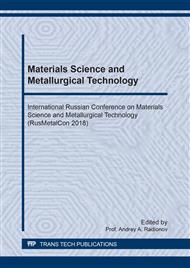[1]
A.P. Tсeplit, A.A. Grigoreva, T.A. Skripkina, The models of supporting the strategic decisions on engineering products competitiveness, Applied Mechanics and Materials. 770 (2015) 656-661.
DOI: 10.4028/www.scientific.net/amm.770.656
Google Scholar
[2]
J. Cao, L.L. Wang, X.P. Mu, The research on product quality competitiveness based on innovation, Advanced Materials Research. 744 (2013) 591-594.
DOI: 10.4028/www.scientific.net/amr.744.591
Google Scholar
[3]
L. Gong, Sh. Tang, J. Xie, X. Chen, Construction and evolution analysis of a technology network for product innovative design. 2017 12th IEEE Conference on Industrial Electronics and Applications, June (2017).
DOI: 10.1109/iciea.2017.8283133
Google Scholar
[4]
S.F. Song, G.J. Li, Y.Sh. Suet, The fuzzy comprehensive assessment of brand competitiveness of property insurance companies, Applied Mechanics and Materials. 55-57 (2011) 1489-1493.
DOI: 10.4028/www.scientific.net/amm.55-57.1489
Google Scholar
[5]
G.F. Qiu, H.F. Gao, Evaluation on core competitiveness of construction enterprise based on multi-level gray evaluation method, Advanced Materials Research. 838-841 (2014) 3096-3101.
DOI: 10.4028/www.scientific.net/amr.838-841.3096
Google Scholar
[6]
Sh. Tang, L. Gong, J. Xie, Y. Liu. A competitiveness evaluation method of product based on technology maturity and development trend, 2017 12th IEEE Conference on Industrial Electronics and Applications, June (2017).
DOI: 10.1109/iciea.2017.8282927
Google Scholar
[7]
L. Song, Y.-sh. Geng, X.-.g. Wang, Research on evaluation method of ability of enterprise technology competition based on patent analysis, Informatics and Management Science IV, January (2013).
DOI: 10.1007/978-1-4471-4793-0_50
Google Scholar
[8]
J. Ryu, S.Ch. Byeon, Technology level evaluation methodology based on the technology growth curve, Technological Forecasting and Social Change. 78(6) (2011) 1049-1059.
DOI: 10.1016/j.techfore.2011.01.003
Google Scholar
[9]
Zh.-Sh. Zhang, X.-L. Zhao, Optimization of evaluation indexes of competitiveness of science technology and innovation based on quantitative approach, Journal of Discrete Mathematical Sciences and Cryptography. 20(6-7) (2017) 1357-1362.
DOI: 10.1080/09720529.2017.1392446
Google Scholar
[10]
G.L. Azoev, Analysis of activities of competitors, GAU, Moscow, (1995).
Google Scholar
[11]
A.N. Rodionov, O.G. Kantor, Yu.I. Khomyakova, Evaluating competitiveness of products, Marketing in Russia and Abroad. 1 (2000) 17–27.
Google Scholar
[12]
E.A. Kobets, Creating and evaluating competitiveness of products of mechanical engineering companies: essence, methods and implementation: dissertation for the degree of PhD (Economics), Taganrog, (2003).
Google Scholar
[13]
V.A. Tanygin, Fundamentals of standardization and quality management, Publishing house of standards, Moscow, (1989).
Google Scholar
[14]
N.P. Goncharova, P.G. Pererva, Marketing of an innovative process, Naukova Dumka, Kiev, (1998).
Google Scholar
[15]
V.I. Zakharchenko, Competitiveness of machine-building products, Marketing in Russia and Abroad. 5 (1999) 26.
Google Scholar
[16]
D. Waterman, A guide to expert systems, Mysl, Moscow, (1989).
Google Scholar
[17]
V.V. Belyakov, M.E. Bushueva, V.I. Sagunov, Multicriteria optimization applied to evaluate competitiveness of mobile motor and tractor equipment and diagnose sophisticated technical systems, Nizhny Novgorod State Technical University, (2001).
Google Scholar
[18]
Z. Ashtianipour, H. Zandhessami, An integrated ISM-DEMATEL model for evaluation of technological innovation capabilities' impact on the competitiveness of small & medium size enterprises (SMEs), 2015 Portland International Conference on Management of Engineering and Technology, August (2015).
DOI: 10.1109/picmet.2015.7273092
Google Scholar
[19]
N.N. Ermoshenko, E.I. Barsuchenko, Key trends in business activities in countries with developed market economies, Ukr ISTEI, Kiev, (1992).
Google Scholar
[20]
Y.-.H. Hwang, Self-certification framework for technological innovation: A case study, International Journal of Quality & Reliability Management, 31(7) (2014) 751-763.
DOI: 10.1108/ijqrm-10-2012-0139
Google Scholar
[21]
T.J. Gordon, T.R. Munson, A proposed convention for measuring the state of the art of products and processes, Technological Forecasting and Social Change. 20(1) (1981) 1-26.
DOI: 10.1016/0040-1625(81)90038-x
Google Scholar
[22]
R.M. Rosenthal. FMEA - a way to increase quality of products, Electronics: Science, Technology, Business. 7 (2010) 90-95.
Google Scholar
[23]
A.S. Amirkhanyan, A.G. Brevnova, Advanced product quality planning, Current problems of Aviation and Cosmonautics. 2(8) (2012) 88–89.
Google Scholar
[24]
V.L. Shper. QFD method, Quality Management Methods. 4 (2015) 52–53.
Google Scholar
[25]
V. Colla, V. Renzo, B. Fornai, A. Amato. Comparison of different alternative steel technologies: Evaluation of case studies for an innovative and sustainable steelwork, Revue de Métallurgie, (2016).
DOI: 10.1051/metal/2016016
Google Scholar
[26]
V.A. Kharitonov, I.M. Petrov, Evaluation of, and trends in an increase in competitiveness of coiled reinforcing bars, Vestnik Nosov Magnitogorsk State Technical University. 4 (2013) 65–69.
Google Scholar
[27]
V.A. Kharitonov, I.M. Petrov, Efficient production of competitive steel rebar, Steel in Translation. 45(7) (2015) 517-520.
DOI: 10.3103/s0967091215070086
Google Scholar


